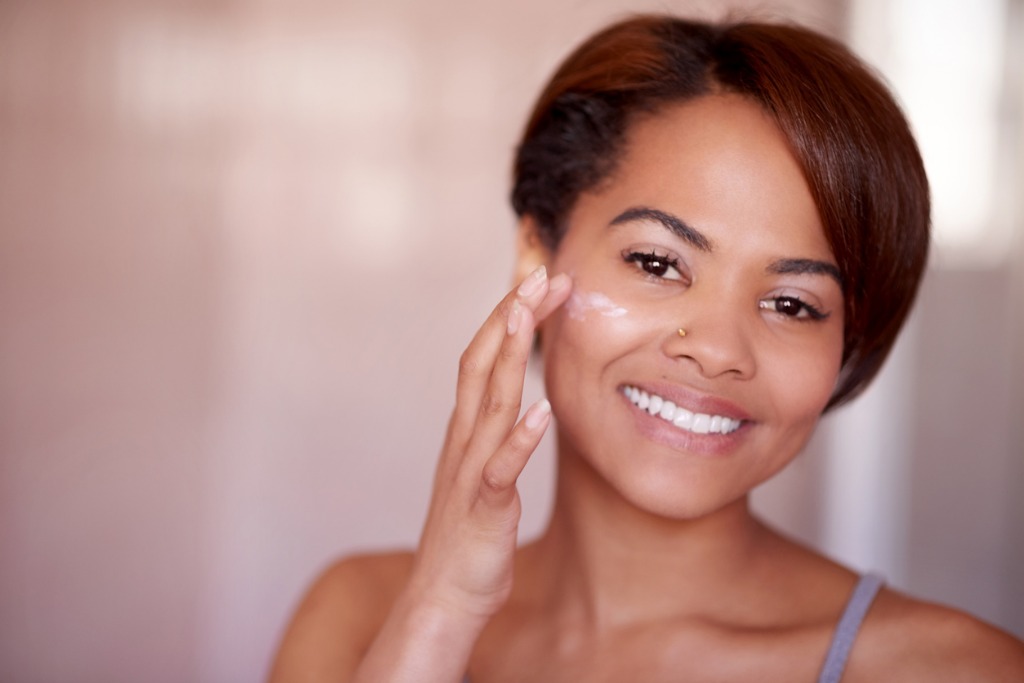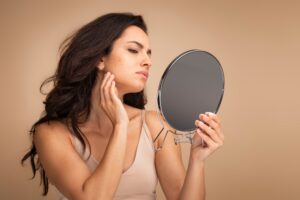Treating Acne
There are many misconceptions about acne, but one thing is sure: it’s the bane of virtually every teenager. But it can also last into the adult years, particularly for women. Acne is a common skin condition, often causing frustration and impacting self-confidence. Whether you’re dealing with occasional breakouts or persistent acne, effective treatment is key to achieving clear, healthy skin.
Dr. Kronberg, a dermatologist in Houston, TX, puts her 30 years of clinical dermatology experience to work in helping her patients deal with their acne.
What Is Acne?
 Clinically known as acne vulgaris, common acne is basically a function of the sebaceous glands located at the base of the hair follicles. These glands produce oil that keeps our hair and skin lubricated and moist. Acne forms when the sebaceous glands become clogged and the oil is trapped beneath the skin. An acne breakout is when these clogged pores become inflamed, appearing as occluded pores (whiteheads and blackheads), red bumps (pimples), pustules, or cysts.
Clinically known as acne vulgaris, common acne is basically a function of the sebaceous glands located at the base of the hair follicles. These glands produce oil that keeps our hair and skin lubricated and moist. Acne forms when the sebaceous glands become clogged and the oil is trapped beneath the skin. An acne breakout is when these clogged pores become inflamed, appearing as occluded pores (whiteheads and blackheads), red bumps (pimples), pustules, or cysts.
Acne usually forms on the face, back, neck, shoulders, and chest.
What Causes Acne?
Despite its prevalence, the causes of acne aren’t completely understood. A combination of factors seems to be involved. Hormones play an important role. In teenagers, the rise in the male sex hormone androgen during puberty causes the sebaceous glands to enlarge and produce more oil. This overproduction of oil can’t be distributed out of the glands quickly enough and some of them clog. In these glands, the p.acnes bacteria that are common now begin to multiply. This causes inflammation, which leads to a breakout. How this progresses varies between people — in some, elevated sebum levels might cause a lone pimple or two; in others, it can be a full outbreak.
Some people seem to be more prone to acne development, and this may have a genetic component. For adult women, hormone fluctuations during pregnancy or when taking certain birth control pills can cause acne breakouts. Acne can be a side effect of some medications. There is even a different form of acne, known as acne mechanica, that comes from the friction and heat generated from sports helmets.
What Doesn’t Cause Acne?
Acne has had more than its share of misconceptions. People long believed that eating chocolate or greasy foods directly led to breakouts. Research has since completely debunked that theory.
Another cause was thought to be personal hygiene. But no relationship between dirty skin and acne has been proven.
At one time, the thought was to dry out the facial skin as much as possible with harsh cleansers and scrubs. This would, in theory, remove the oil and open the pores. Actually, this leads to increased skin irritation and can exacerbate acne.
How Common Is Acne and Who Gets It?
This isn’t news, but acne is the most common skin disorder of teenagers, affecting roughly 85 percent of teens as some point between the ages of 13 and 20. This is obviously a result of the raging hormones of puberty.
In adults, women are more likely to have mild to moderate forms of acne into their 30s and sometimes beyond.
Types of Acne
Acne vulgaris is the medical term for common acne, with the presence of blackheads, whiteheads, and other types of pimples on the skin. Often the type of breakout is how acne is categorized.
- Whiteheads — A comedo is a basic acne lesion, a hair follicle that has become clogged with oil and dead skin cells. If the comedone is closed at the surface skin, it forms a whitehead.
- Blackheads — These are comedones that are open at the surface of the skin. They are filled with excess oil and dead skin cells. People think it is dirt that turns these lesions black, but it isn’t. It is simply the irregular reflection of light coming from the clogged follicles.
- Papules — If the comedones become inflamed they form small red or pink bumps on the skin. These are papules, and they may be sensitive to the touch.
- Pustules — These resemble whiteheads with a red ring around the bump.
- Nodules — Nodules develop deep within the skin and develop into a large, inflamed bump that feels firm to the touch. They are often painful.
- Cysts — Cystic acne is the most severe form, and it leads to permanent acne scarring. Cysts are large, pus-filled lesions that resemble boils.
Relationship Between Hormones and Acne?
 Hormones are the main driver of acne. Androgen is a staple of puberty in both girls and boys. This male sex hormone triggers excess oil production in the sebaceous glands, leading to those glands clogging and becoming inflamed. Hormonal changes related to pregnancy and in birth control pills can cause the same increase in sebum production in adult women.
Hormones are the main driver of acne. Androgen is a staple of puberty in both girls and boys. This male sex hormone triggers excess oil production in the sebaceous glands, leading to those glands clogging and becoming inflamed. Hormonal changes related to pregnancy and in birth control pills can cause the same increase in sebum production in adult women.
Topical Medications
- Retinoids — These drugs are derived from vitamin A and include tretinoin, adapalene, and tazarotene. They come in cream, gel, and lotion forms. They work by preventing plugging of the hair follicles.
- Antibiotics — Antibiotics work by killing excess skin bacteria and reducing inflammation. They are usually combined with a retinoid and benzoyl peroxide (to reduce the risk of developing antibiotic resistance.)
- Salicylic acid and azelaic acid — Salicylic acid helps prevent hair follicle clogging and azelaic acid has antibacterial properties.
- Dapsone — This is used with inflammatory acne, especially in adult women.
Oral Medications
- Antibiotics — Oral antibiotics are used to reduce bacteria in the sebaceous glands and to fight inflammation. These cannot be used for long periods as resistance can develop.
- Combined oral contraceptives — Combined oral contraceptives are approved by the FDA for treatment of acne. They combine estrogen and progestin.
- Anti-androgen agents — The drug spironolactone can be used for adolescent girls and adult women if oral antibiotics aren’t helping. This drug works by blocking the effect of androgen hormones on the sebaceous glands.
- Isotretinoin — This is a powerful drug that is very effective in cases of acne that don’t respond to other treatments. The brand name Accutane is the most well known of these drugs, but it is no longer on the market.
Other Acne Treatments
Beyond medications, Dr. Kronberg may use laser and light therapies and chemical peels to treat acne. Sometimes these are combined with medications.
- Lasers and photodynamic therapy — A variety of light therapies can be effective in treating acne. In some cases, the light is applied with an activation chemical known as Levulan. The goal of these treatments is to kill the bacteria that are multiplying in the clogged hair follicles, causing inflammation and breakouts. Fotofacials use Intense Pulsed Light. Regenlite is a pulsed dye laser.
- Chemical peels — Chemical peels use a peeling agent, usually salicylic acid, glycolic acid, or retinoic acid to remove some of the surface skin. These can improve clogged hair follicles and remove some surface bacteria, but their effects are not long lasting.
- Steroid injections — With cystic acne, Dr. Kronberg may choose to inject a corticosteroid directly into the lesion. This can rapidly shrink the lesion and decrease pain.
Why Choose Dr. Esta Kronberg, M.D. for Acne Treatment?
With nearly 40 years of experience, Dr. Esta Kronberg, M.D. is a board-certified dermatologist and a trusted authority in the field of dermatology. A pioneer in cosmetic dermatology in Austin and Houston, Dr. Kronberg combines her deep expertise with the latest advancements in acne treatment. Her personalized approach ensures that each patient is treated as an individual case with a treatment plan designed for their skin needs. No matter the type of acne you are dealing with, Dr. Kronberg will dedicate her time and expertise to helping you achieve clear, healthy skin with lasting results to boost your confidence. Her unwavering dedication to patient care and proven results make her a top choice for effective acne treatment.
Frequently Asked Questions (FAQs)
Can acne be cured permanently?
While there is currently no permanent cure for acne, it can be managed and controlled effectively with the right treatment plan. Consistency is key to long-term improvement.
Can stress cause acne?
Yes, stress can trigger acne flare-ups by increasing oil production and causing inflammation, which may lead to more breakouts.
Does acne leave scars?
Acne can leave scars, especially if the lesions are picked or squeezed. Early and proper treatment can help prevent acne scarring.
What is the best skincare routine for acne-prone skin?
A good routine includes:
- Gentle cleansing.
- Using non-comedogenic (won't clog pores) products.
- Exfoliating to remove dead skin cells.
- Moisturizing with oil-free products.
Sun protection is also essential.
How long does it take to see results from acne treatments?
Results vary depending on the treatment and the severity of acne. Some treatments may show improvement within a few weeks, while others, like prescription medications, may take a few months.
Can makeup make acne worse?
Yes, makeup can worsen acne, especially if it contains pore-clogging ingredients. Non-comedogenic and oil-free makeup products are recommended for acne-prone skin.
How long does it take to see results from acne treatments?
Results vary depending on the treatment and the severity of acne. Some treatments may show improvement within a few weeks, while others, like prescription medications, may take a few months.
Which areas of the body can acne be treated?
Acne can appear on various parts of the body, including the back, chest, shoulders, neck, and even the upper arms. Dermatologists can provide targeted treatments for acne on any of these body areas to help clear up blemishes and prevent future breakouts.
Schedule a Consultation
If you have acne and are looking for a top dermatologist in Houston, call 713-771-8941 to schedule a consultation with Dr. Kronberg or call 713-988-8442 . During your consultation, Dr. Kronberg will perform a full evaluation and recommend an acne treatment plan to help get you the clear skin you always wanted.




